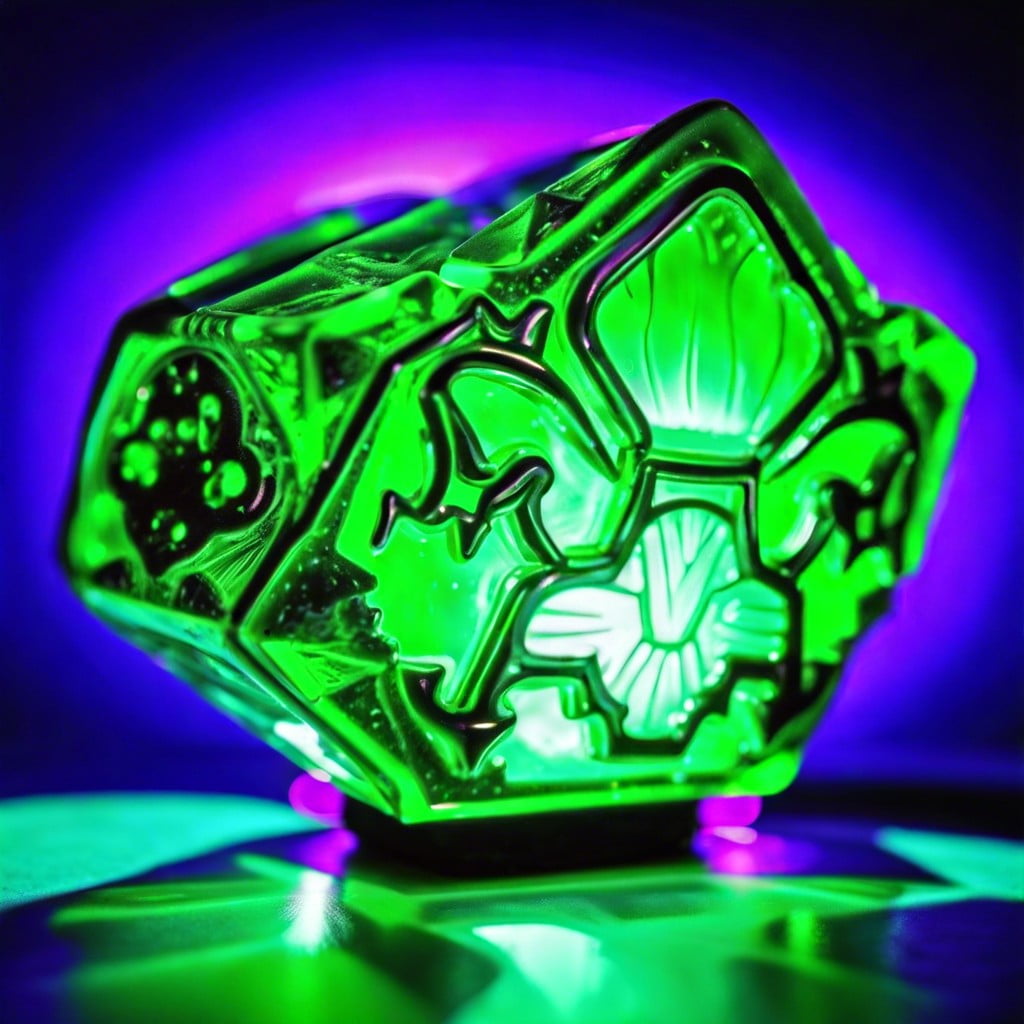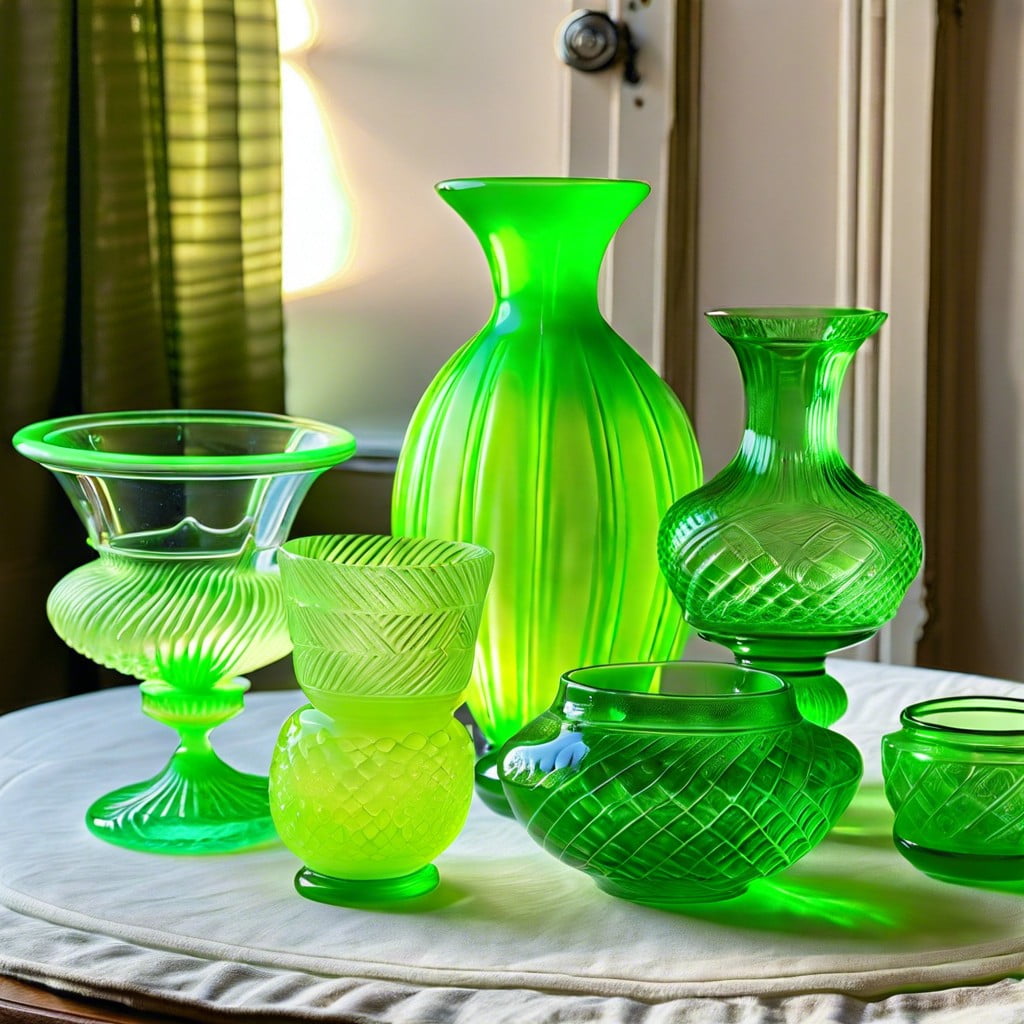Last updated on
Identifying uranium glass becomes a fascinating quest because it reveals the beautiful secrets of this highly unique and radiant material.
Key takeaways:
- Uranium glass emits a distinct green or green-yellow hue.
- Look for color variances and a heavier weight in uranium glass.
- Use a black light to confirm the presence of uranium.
- Use a Geiger counter to detect low levels of radioactivity.
- Understand the differences between uranium glass and similar types.
Characteristics of Uranium Glass

Uranium glass emits a distinct green, yellow, or green-yellow hue, a direct result of its uranium content, which can range from 0.1% to over 25%. This unique coloration often becomes more pronounced under natural light.
Pieces produced during the early 20th century may demonstrate a slightly radioactive signature, which stems from their uranium content, though typically at levels considered safe for handling and use. The glass may also fluoresce under UV light, giving off a bright neon green glow due to the uranium.
Differences in production techniques and the mixture of elements can result in variations of color intensity and opaqueness, with some pieces appearing almost transparent and others having a milky, opaque finish. It is this combination of visual and physical characteristics that guides collectors and enthusiasts in identifying genuine uranium glass.
Identifying Uranium Glass Without UV Light

When assessing glassware without the aid of a UV light, observe the following features to determine if you have a piece of uranium glass:
- Coloration: Uranium glass typically displays a green to yellowish-green hue, although this can range from opaque to transparent.
- Sunlight Test: Place the piece in natural sunlight. Uranium glass often has a subtle fluorescent quality in bright light, different than similar non-uranium glasses.
- Thickness and Color Variance: Look at the edges or thicker parts of the glass. Uranium-infused pieces frequently show a darker color concentration in these areas compared to the rest of the item.
- Pattern and Shape: Familiarize yourself with common patterns and shapes of uranium glass, as these often date back to periods when its production was more prevalent.
- Heft: Many collectors note a distinct heaviness in uranium glass pieces when compared to non-uranium glassware of similar size.
- Sound: Lightly tap the item. Uranium glass can produce a ringing sound, distinct from the duller thud of other types of glass when struck gently.
By integrating these observational tactics, you can competently surmise the likelihood of a glassware item being genuine uranium glass even in the absence of black light testing.
Black Light Test for Uranium Glass
A reliable method for confirming the presence of uranium in glass is using a black light, or UV light. When placed under UV light, uranium glass typically glows a bright green or yellow color due to the uranium content fluorescing.
Here are the steps to carry out this test effectively:
- Safety First: Ensure the area is dimly lit to observe the fluorescence clearly, but be mindful of your surroundings to avoid accidents.
- Black Light Use: Shine the UV light directly onto the glass. A handheld black light works best for this purpose.
- Observation: Look for a green or yellow glow. The intensity of the glow can vary depending on the concentration of uranium within the glass.
- Variability: Note that the thickness of the glass and the age can affect the visibility of the fluorescence.
- Compare: If possible, compare the suspect piece with a known piece of uranium glass to see if the glow is similar.
Using a black light is a quick, non-invasive test that can usually identify uranium glass with confidence. Remember that not every green or yellow glass will fluoresce under UV light, so this is a key step distinguishing uranium glass from other types.
Geiger Counter Testing
A Geiger counter, a device responsive to ionizing radiation, can detect the low levels of radioactivity emitted by uranium glass. Since uranium is a radioactive element, the counter’s accuracy in identifying this type of glass hinges on the presence of uranium oxide within the item.
For effective use of a Geiger counter:
- Safety First: Ensure the unit is properly calibrated for low-level radiation and that you’re familiar with its safe operation.
- Test Preparation: Clean the glass item to remove any dust or grime that could interfere with the reading.
- Close Proximity: Hold the Geiger counter’s sensor near the surface of the glass. Distance can drastically affect the sensitivity and the ability to detect radiation.
- Background Levels: Take a baseline measurement away from the glass to understand the normal background radiation for comparison.
- Interpreting Results: A noticeable increase in clicks or readings from the counter when near the glass suggests the presence of radioactive materials, likely uranium.
- Follow-Up: Positive readings should be followed with further research or professional appraisal to confirm the composition and ensure proper handling.
Remember that Geiger counters vary in sensitivity and some vintage or less sensitive models may not detect the relatively low radiation levels of uranium glass. Always refer to the manufacturer’s guidelines for specifics about the detection capabilities of your device.
Recognizing Similar Types of Glass
When differentiating uranium glass from other types of glass, consider the following points:
- Color and Appearance: Unlike uranium glass, which typically exhibits a green to yellowish-green hue, look-alike pieces may appear similar but lack the characteristic glow under UV light. Some Depression glass, while similarly colored, does not contain uranium and won’t fluoresce.
- Thickness and Texture: Uranium glass tends to have a certain thickness and a smooth texture, contrasting with some forms of antique glass which may be thinner or display unevenness due to manufacturing techniques of their era.
- Pattern and Design: Certain patterns are distinctive to uranium glass, mostly from specific historical periods like the Art Deco era. Familiarize yourself with popular patterns, as other types of glass won’t usually share these designs.
- Fluorescence: A key distinguishing factor is fluorescence. Other green glasses might imitate the look but won’t emit the tell-tale green glow under UV light.
Remember, while these guidelines can help differentiate uranium glass from similar materials, consulting with an expert or utilizing a black light test can provide additional assurance in your determination.
Historical Context and Production Periods
Uranium glass, a type of glassware, has a rich history dating back to the 19th century. Joseph Riedel first patented it in 1830 in Austria. The production soon spread, reaching a peak in popularity from the 1880s to the early 20th century, mainly in countries such as the United States, the UK, and Czechoslovakia.
During the Art Deco period in the 1920s and 1930s, uranium was commonly added to glass mixtures to achieve a variety of colors, including green, yellow, and blue hues. This period saw a surge in the creation of vaseline and custard glass, both varieties of uranium glass distinguished by their specific coloration—vaseline glass typically appears greener, while custard glass has a more muted, creamy hue.
Post-World War II, the use of uranium in glass manufacturing decreased significantly due to government restrictions on uranium use for military purposes. Production resumed to a lesser extent after the uranium supply became more available in the 1950s. However, the usage never again reached the heights of the glassware’s heyday.
Collectors often seek glass from these distinct periods for its historical significance and unique properties. Familiarity with the typical styles and manufacturing techniques of the era can assist enthusiasts in identifying genuine pieces from subsequent reproductions.
Vaseline Glass Versus Uranium Glass
Understanding the distinction between Vaseline glass and uranium glass is crucial for collectors and enthusiasts. Although these terms are often used interchangeably, there are subtle differences:
1. Color: Vaseline glass typically exhibits a bright, fluorescent yellow-green hue due to the uranium content, but may range to a yellowish tone without green.
2. Presence of Uranium: While both glasses contain uranium, not all Vaseline glass will show a strong reaction under UV light, indicating a lower concentration of uranium.
3. Era of Production: Vaseline glass was produced as early as the 1830s, while the term “uranium glass” gained popularity later, with increased production in the early 20th century.
4. Additional Materials: Vaseline glass may contain other additives giving it an opaque or translucent appearance, which can affect its glow under UV light.
In identifying and differentiating these glasses, take note of their color and luminescence. Collectors should also research the manufacturer and production period for further clarification on the type of glass in question.
Determining the Value of Uranium Glass
Several factors influence the value of uranium glass. The rarity of the piece plays a significant role; patterns and items that were produced in limited quantities typically command higher prices. Condition is also crucial; chips, cracks, or significant wear can greatly reduce value. The color intensity, which varies depending on the amount of uranium used during production, can affect desirability, with deeper, more vibrant colors often being more sought after. The provenance, or history, of a uranium glass item can add to its value, especially if it can be traced to a notable owner or was manufactured by a well-respected company.
Additionally, the artistry and intricacy of the design contribute to the overall worth. Collectors generally pay a premium for pieces with intricate patterns, elaborate shapes, and hand-crafted details. It’s important to research the market and compare similar items to get an accurate valuation. Consulting with a knowledgeable antique dealer or appraiser who specializes in vintage glassware can provide expert insight into the current market value of a piece.
Safety Concerns With Uranium Glass
While uranium glass contains radioactive material, the levels are generally seen as too low to pose a health risk under normal circumstances. However, it’s worth considering the following points:
- Handling: Occasional handling of uranium glass is considered safe. Frequent or prolonged exposure could increase risks, so it’s best to minimize direct contact.
- Use: Using uranium glass for food or beverages is discouraged. While the risk of leaching is low, acidic foods or drinks could potentially increase the likelihood of uranium release.
- Storage: Displaying uranium glass in living areas is acceptable; avoid storing it in spaces where people spend a significant amount of time, such as bedrooms, to minimize long-term exposure.
- Disposal: If you decide to dispose of uranium glass, check local regulations. Some areas may require it to be treated as low-level radioactive waste.
- Collecting: For collectors, it’s advisable to use protective gloves and store pieces in well-ventilated cabinets with limited access to reduce exposure.
Transforming concerns into considerations ensures responsible ownership and enjoyment of these unique historical artifacts.
Guidance On Purchasing Uranium Glass Today
When considering the addition of uranium glass to your collection, focus on reputable dealers or knowledgeable sellers. Online platforms can be resourceful but require vigilance to avoid misidentified pieces. Research the sellers, read reviews, and don’t hesitate to inquire about the glass’s origin, age, and authentication evidence.
At antique stores or flea markets, employ a portable black light to verify the presence of uranium. Ask for permission before testing to maintain good etiquette. Prices for uranium glass can vary greatly, so be informed about the market value and factors affecting cost, including rarity and condition.
Be mindful of local regulations about the transport and ownership of uranium glass, especially when purchasing from international vendors. Insure your shipment; given the fragility and potential value of the glass, it is important to protect your investment against loss or damage in transit.
Bear in mind that while uranium glass emits radiation, it is typically below levels considered harmful; however, educating yourself on the safe handling and display of these pieces is advisable. Balancing appreciation for its unique glow with due diligence ensures a satisfying and responsible collecting experience.




